English Law Legal System - Assignment
VerifiedAdded on 2021/01/08
|10
|3368
|72
AI Summary
Contribute Materials
Your contribution can guide someone’s learning journey. Share your
documents today.
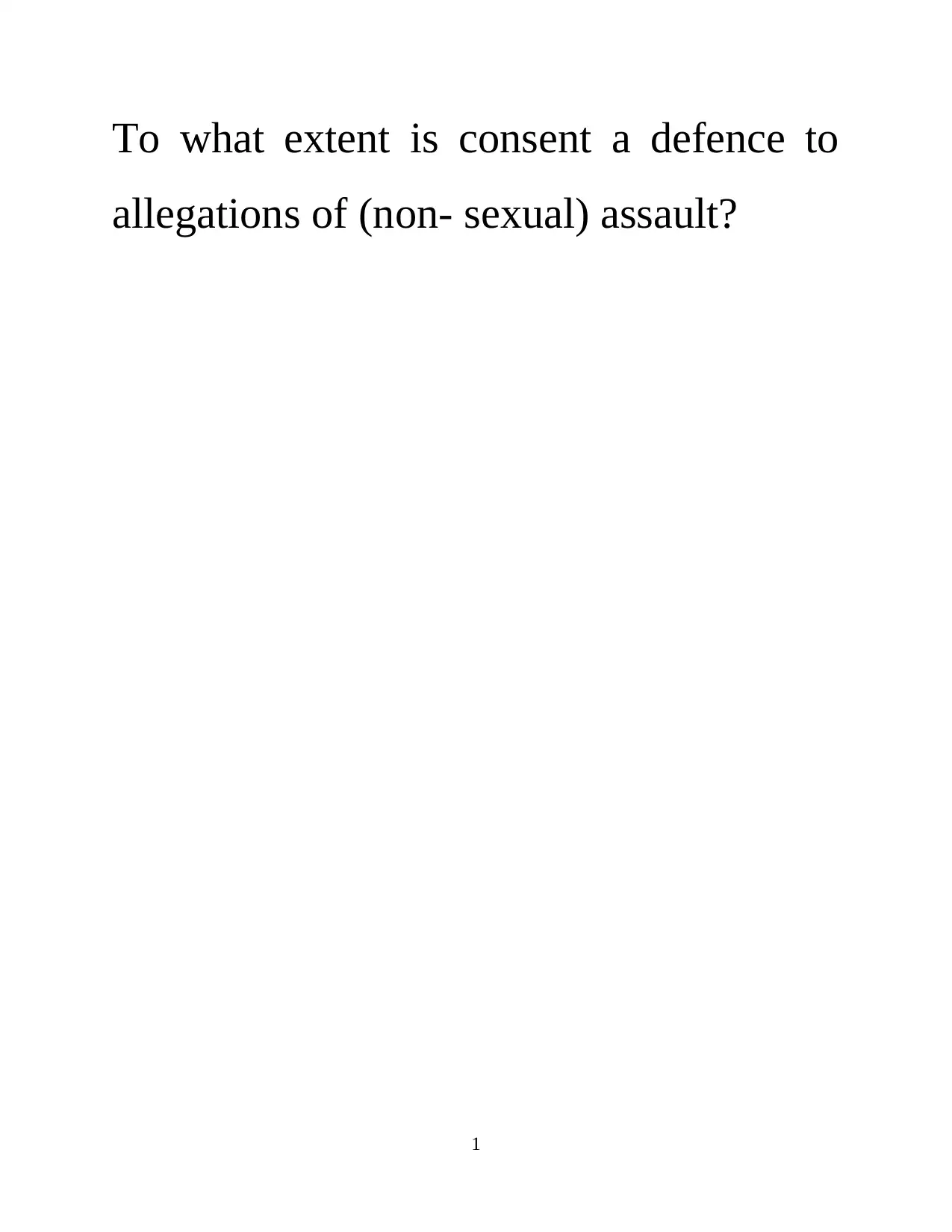
To what extent is consent a defence to
allegations of (non- sexual) assault?
1
allegations of (non- sexual) assault?
1
Secure Best Marks with AI Grader
Need help grading? Try our AI Grader for instant feedback on your assignments.
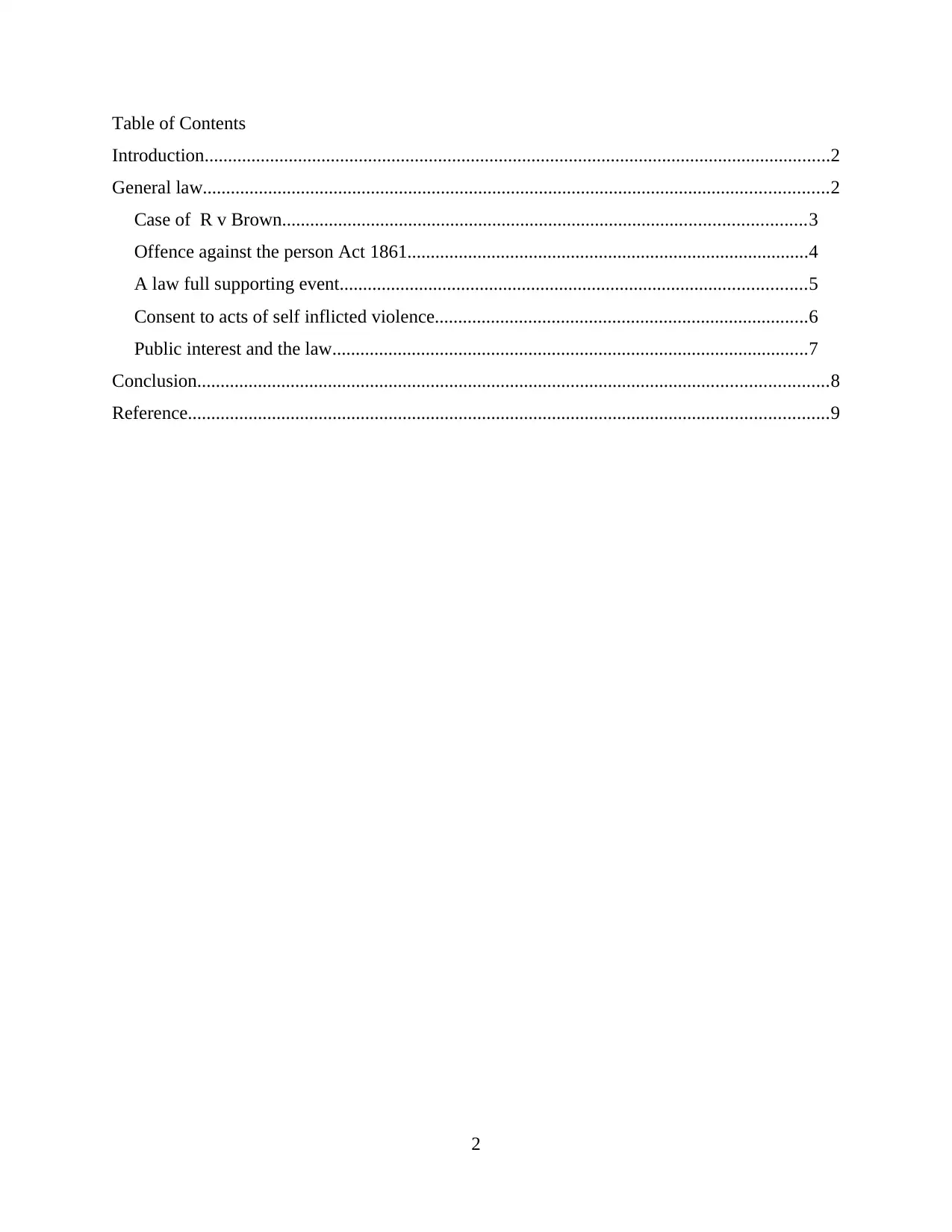
Table of Contents
Introduction......................................................................................................................................2
General law......................................................................................................................................2
Case of R v Brown................................................................................................................3
Offence against the person Act 1861......................................................................................4
A law full supporting event....................................................................................................5
Consent to acts of self inflicted violence................................................................................6
Public interest and the law......................................................................................................7
Conclusion.......................................................................................................................................8
Reference.........................................................................................................................................9
2
Introduction......................................................................................................................................2
General law......................................................................................................................................2
Case of R v Brown................................................................................................................3
Offence against the person Act 1861......................................................................................4
A law full supporting event....................................................................................................5
Consent to acts of self inflicted violence................................................................................6
Public interest and the law......................................................................................................7
Conclusion.......................................................................................................................................8
Reference.........................................................................................................................................9
2
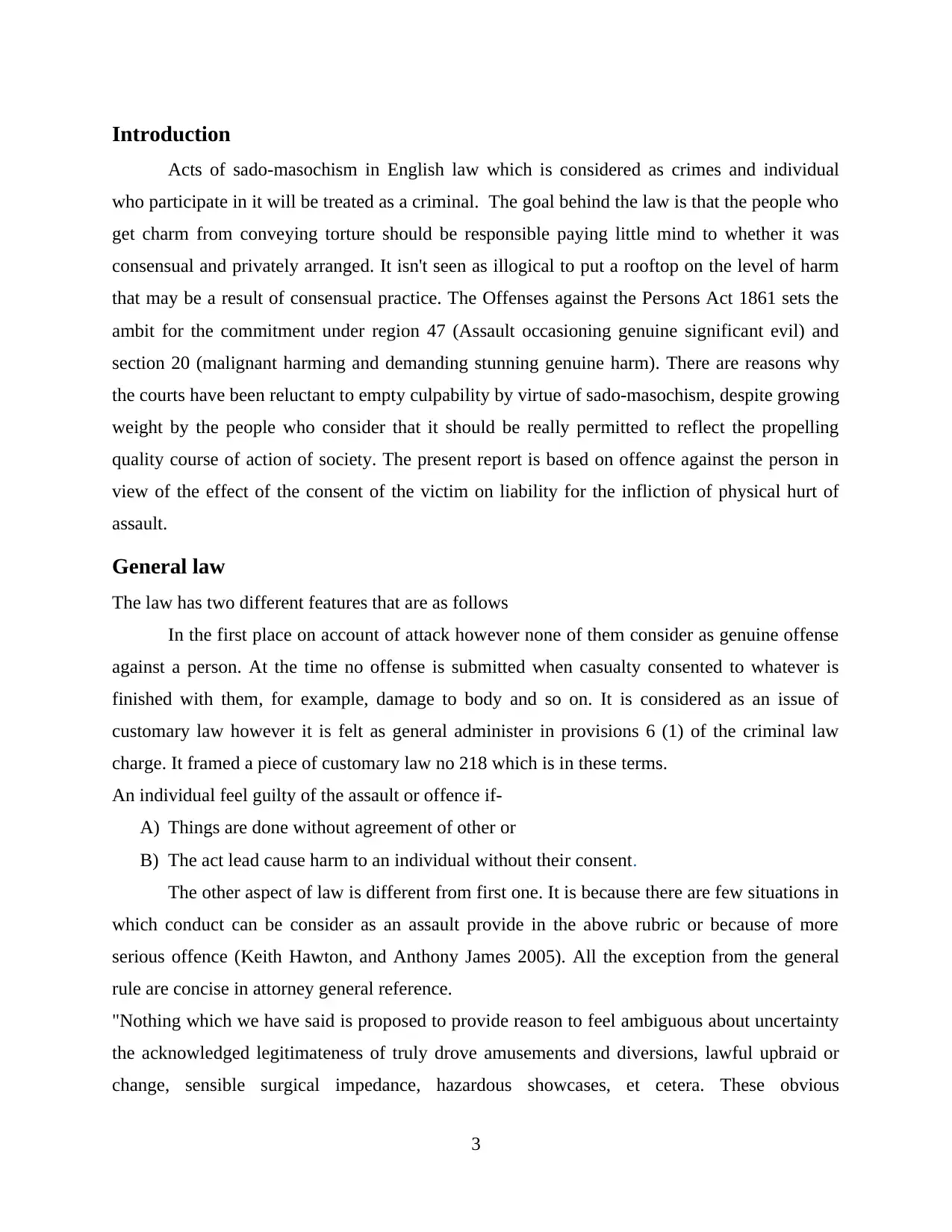
Introduction
Acts of sado-masochism in English law which is considered as crimes and individual
who participate in it will be treated as a criminal. The goal behind the law is that the people who
get charm from conveying torture should be responsible paying little mind to whether it was
consensual and privately arranged. It isn't seen as illogical to put a rooftop on the level of harm
that may be a result of consensual practice. The Offenses against the Persons Act 1861 sets the
ambit for the commitment under region 47 (Assault occasioning genuine significant evil) and
section 20 (malignant harming and demanding stunning genuine harm). There are reasons why
the courts have been reluctant to empty culpability by virtue of sado-masochism, despite growing
weight by the people who consider that it should be really permitted to reflect the propelling
quality course of action of society. The present report is based on offence against the person in
view of the effect of the consent of the victim on liability for the infliction of physical hurt of
assault.
General law
The law has two different features that are as follows
In the first place on account of attack however none of them consider as genuine offense
against a person. At the time no offense is submitted when casualty consented to whatever is
finished with them, for example, damage to body and so on. It is considered as an issue of
customary law however it is felt as general administer in provisions 6 (1) of the criminal law
charge. It framed a piece of customary law no 218 which is in these terms.
An individual feel guilty of the assault or offence if-
A) Things are done without agreement of other or
B) The act lead cause harm to an individual without their consent.
The other aspect of law is different from first one. It is because there are few situations in
which conduct can be consider as an assault provide in the above rubric or because of more
serious offence (Keith Hawton, and Anthony James 2005). All the exception from the general
rule are concise in attorney general reference.
"Nothing which we have said is proposed to provide reason to feel ambiguous about uncertainty
the acknowledged legitimateness of truly drove amusements and diversions, lawful upbraid or
change, sensible surgical impedance, hazardous showcases, et cetera. These obvious
3
Acts of sado-masochism in English law which is considered as crimes and individual
who participate in it will be treated as a criminal. The goal behind the law is that the people who
get charm from conveying torture should be responsible paying little mind to whether it was
consensual and privately arranged. It isn't seen as illogical to put a rooftop on the level of harm
that may be a result of consensual practice. The Offenses against the Persons Act 1861 sets the
ambit for the commitment under region 47 (Assault occasioning genuine significant evil) and
section 20 (malignant harming and demanding stunning genuine harm). There are reasons why
the courts have been reluctant to empty culpability by virtue of sado-masochism, despite growing
weight by the people who consider that it should be really permitted to reflect the propelling
quality course of action of society. The present report is based on offence against the person in
view of the effect of the consent of the victim on liability for the infliction of physical hurt of
assault.
General law
The law has two different features that are as follows
In the first place on account of attack however none of them consider as genuine offense
against a person. At the time no offense is submitted when casualty consented to whatever is
finished with them, for example, damage to body and so on. It is considered as an issue of
customary law however it is felt as general administer in provisions 6 (1) of the criminal law
charge. It framed a piece of customary law no 218 which is in these terms.
An individual feel guilty of the assault or offence if-
A) Things are done without agreement of other or
B) The act lead cause harm to an individual without their consent.
The other aspect of law is different from first one. It is because there are few situations in
which conduct can be consider as an assault provide in the above rubric or because of more
serious offence (Keith Hawton, and Anthony James 2005). All the exception from the general
rule are concise in attorney general reference.
"Nothing which we have said is proposed to provide reason to feel ambiguous about uncertainty
the acknowledged legitimateness of truly drove amusements and diversions, lawful upbraid or
change, sensible surgical impedance, hazardous showcases, et cetera. These obvious
3
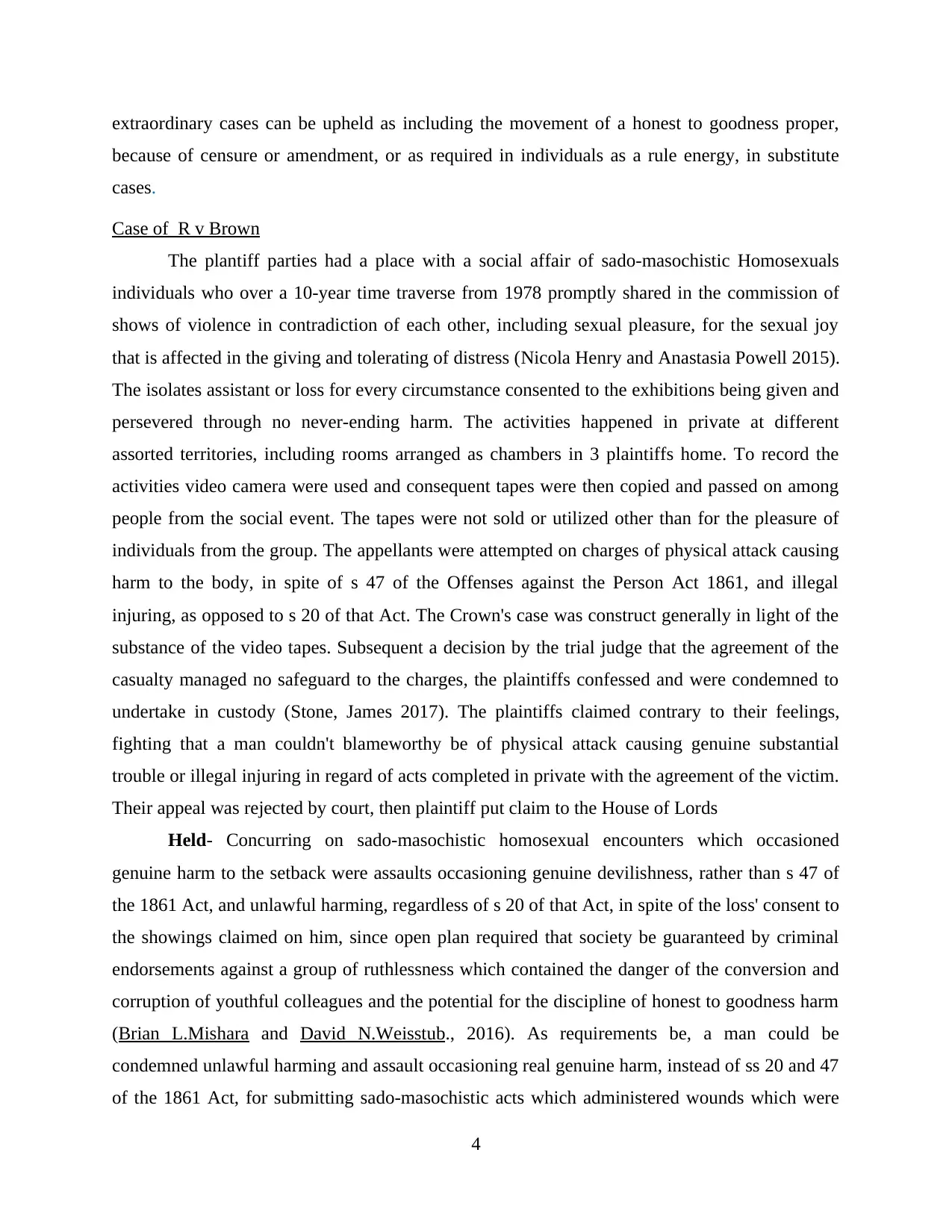
extraordinary cases can be upheld as including the movement of a honest to goodness proper,
because of censure or amendment, or as required in individuals as a rule energy, in substitute
cases.
Case of R v Brown
The plantiff parties had a place with a social affair of sado-masochistic Homosexuals
individuals who over a 10-year time traverse from 1978 promptly shared in the commission of
shows of violence in contradiction of each other, including sexual pleasure, for the sexual joy
that is affected in the giving and tolerating of distress (Nicola Henry and Anastasia Powell 2015).
The isolates assistant or loss for every circumstance consented to the exhibitions being given and
persevered through no never-ending harm. The activities happened in private at different
assorted territories, including rooms arranged as chambers in 3 plaintiffs home. To record the
activities video camera were used and consequent tapes were then copied and passed on among
people from the social event. The tapes were not sold or utilized other than for the pleasure of
individuals from the group. The appellants were attempted on charges of physical attack causing
harm to the body, in spite of s 47 of the Offenses against the Person Act 1861, and illegal
injuring, as opposed to s 20 of that Act. The Crown's case was construct generally in light of the
substance of the video tapes. Subsequent a decision by the trial judge that the agreement of the
casualty managed no safeguard to the charges, the plaintiffs confessed and were condemned to
undertake in custody (Stone, James 2017). The plaintiffs claimed contrary to their feelings,
fighting that a man couldn't blameworthy be of physical attack causing genuine substantial
trouble or illegal injuring in regard of acts completed in private with the agreement of the victim.
Their appeal was rejected by court, then plaintiff put claim to the House of Lords
Held- Concurring on sado-masochistic homosexual encounters which occasioned
genuine harm to the setback were assaults occasioning genuine devilishness, rather than s 47 of
the 1861 Act, and unlawful harming, regardless of s 20 of that Act, in spite of the loss' consent to
the showings claimed on him, since open plan required that society be guaranteed by criminal
endorsements against a group of ruthlessness which contained the danger of the conversion and
corruption of youthful colleagues and the potential for the discipline of honest to goodness harm
(Brian L.Mishara and David N.Weisstub., 2016). As requirements be, a man could be
condemned unlawful harming and assault occasioning real genuine harm, instead of ss 20 and 47
of the 1861 Act, for submitting sado-masochistic acts which administered wounds which were
4
because of censure or amendment, or as required in individuals as a rule energy, in substitute
cases.
Case of R v Brown
The plantiff parties had a place with a social affair of sado-masochistic Homosexuals
individuals who over a 10-year time traverse from 1978 promptly shared in the commission of
shows of violence in contradiction of each other, including sexual pleasure, for the sexual joy
that is affected in the giving and tolerating of distress (Nicola Henry and Anastasia Powell 2015).
The isolates assistant or loss for every circumstance consented to the exhibitions being given and
persevered through no never-ending harm. The activities happened in private at different
assorted territories, including rooms arranged as chambers in 3 plaintiffs home. To record the
activities video camera were used and consequent tapes were then copied and passed on among
people from the social event. The tapes were not sold or utilized other than for the pleasure of
individuals from the group. The appellants were attempted on charges of physical attack causing
harm to the body, in spite of s 47 of the Offenses against the Person Act 1861, and illegal
injuring, as opposed to s 20 of that Act. The Crown's case was construct generally in light of the
substance of the video tapes. Subsequent a decision by the trial judge that the agreement of the
casualty managed no safeguard to the charges, the plaintiffs confessed and were condemned to
undertake in custody (Stone, James 2017). The plaintiffs claimed contrary to their feelings,
fighting that a man couldn't blameworthy be of physical attack causing genuine substantial
trouble or illegal injuring in regard of acts completed in private with the agreement of the victim.
Their appeal was rejected by court, then plaintiff put claim to the House of Lords
Held- Concurring on sado-masochistic homosexual encounters which occasioned
genuine harm to the setback were assaults occasioning genuine devilishness, rather than s 47 of
the 1861 Act, and unlawful harming, regardless of s 20 of that Act, in spite of the loss' consent to
the showings claimed on him, since open plan required that society be guaranteed by criminal
endorsements against a group of ruthlessness which contained the danger of the conversion and
corruption of youthful colleagues and the potential for the discipline of honest to goodness harm
(Brian L.Mishara and David N.Weisstub., 2016). As requirements be, a man could be
condemned unlawful harming and assault occasioning real genuine harm, instead of ss 20 and 47
of the 1861 Act, for submitting sado-masochistic acts which administered wounds which were
4
Secure Best Marks with AI Grader
Need help grading? Try our AI Grader for instant feedback on your assignments.
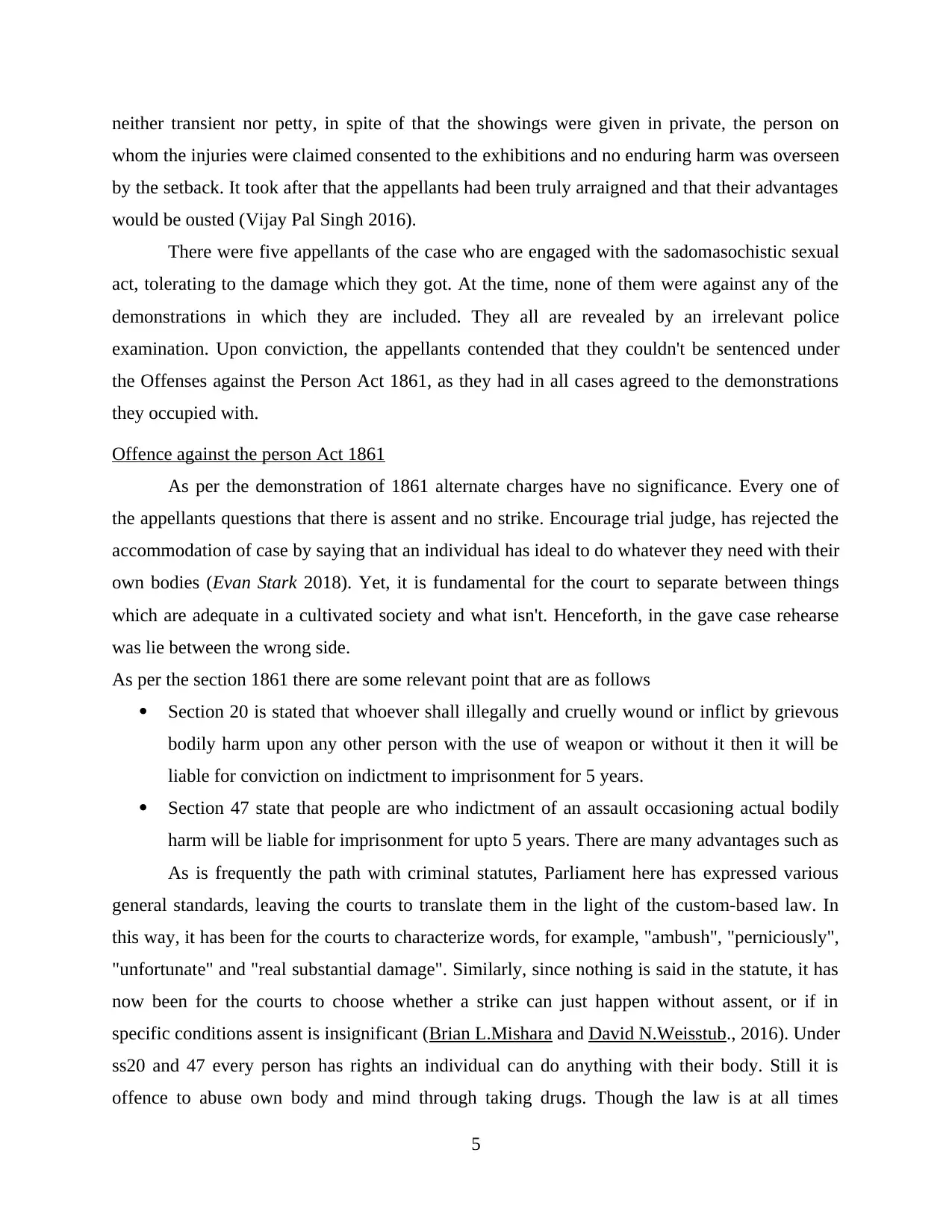
neither transient nor petty, in spite of that the showings were given in private, the person on
whom the injuries were claimed consented to the exhibitions and no enduring harm was overseen
by the setback. It took after that the appellants had been truly arraigned and that their advantages
would be ousted (Vijay Pal Singh 2016).
There were five appellants of the case who are engaged with the sadomasochistic sexual
act, tolerating to the damage which they got. At the time, none of them were against any of the
demonstrations in which they are included. They all are revealed by an irrelevant police
examination. Upon conviction, the appellants contended that they couldn't be sentenced under
the Offenses against the Person Act 1861, as they had in all cases agreed to the demonstrations
they occupied with.
Offence against the person Act 1861
As per the demonstration of 1861 alternate charges have no significance. Every one of
the appellants questions that there is assent and no strike. Encourage trial judge, has rejected the
accommodation of case by saying that an individual has ideal to do whatever they need with their
own bodies (Evan Stark 2018). Yet, it is fundamental for the court to separate between things
which are adequate in a cultivated society and what isn't. Henceforth, in the gave case rehearse
was lie between the wrong side.
As per the section 1861 there are some relevant point that are as follows
Section 20 is stated that whoever shall illegally and cruelly wound or inflict by grievous
bodily harm upon any other person with the use of weapon or without it then it will be
liable for conviction on indictment to imprisonment for 5 years.
Section 47 state that people are who indictment of an assault occasioning actual bodily
harm will be liable for imprisonment for upto 5 years. There are many advantages such as
As is frequently the path with criminal statutes, Parliament here has expressed various
general standards, leaving the courts to translate them in the light of the custom-based law. In
this way, it has been for the courts to characterize words, for example, "ambush", "perniciously",
"unfortunate" and "real substantial damage". Similarly, since nothing is said in the statute, it has
now been for the courts to choose whether a strike can just happen without assent, or if in
specific conditions assent is insignificant (Brian L.Mishara and David N.Weisstub., 2016). Under
ss20 and 47 every person has rights an individual can do anything with their body. Still it is
offence to abuse own body and mind through taking drugs. Though the law is at all times
5
whom the injuries were claimed consented to the exhibitions and no enduring harm was overseen
by the setback. It took after that the appellants had been truly arraigned and that their advantages
would be ousted (Vijay Pal Singh 2016).
There were five appellants of the case who are engaged with the sadomasochistic sexual
act, tolerating to the damage which they got. At the time, none of them were against any of the
demonstrations in which they are included. They all are revealed by an irrelevant police
examination. Upon conviction, the appellants contended that they couldn't be sentenced under
the Offenses against the Person Act 1861, as they had in all cases agreed to the demonstrations
they occupied with.
Offence against the person Act 1861
As per the demonstration of 1861 alternate charges have no significance. Every one of
the appellants questions that there is assent and no strike. Encourage trial judge, has rejected the
accommodation of case by saying that an individual has ideal to do whatever they need with their
own bodies (Evan Stark 2018). Yet, it is fundamental for the court to separate between things
which are adequate in a cultivated society and what isn't. Henceforth, in the gave case rehearse
was lie between the wrong side.
As per the section 1861 there are some relevant point that are as follows
Section 20 is stated that whoever shall illegally and cruelly wound or inflict by grievous
bodily harm upon any other person with the use of weapon or without it then it will be
liable for conviction on indictment to imprisonment for 5 years.
Section 47 state that people are who indictment of an assault occasioning actual bodily
harm will be liable for imprisonment for upto 5 years. There are many advantages such as
As is frequently the path with criminal statutes, Parliament here has expressed various
general standards, leaving the courts to translate them in the light of the custom-based law. In
this way, it has been for the courts to characterize words, for example, "ambush", "perniciously",
"unfortunate" and "real substantial damage". Similarly, since nothing is said in the statute, it has
now been for the courts to choose whether a strike can just happen without assent, or if in
specific conditions assent is insignificant (Brian L.Mishara and David N.Weisstub., 2016). Under
ss20 and 47 every person has rights an individual can do anything with their body. Still it is
offence to abuse own body and mind through taking drugs. Though the law is at all times
5

wrecked. The criminal law confines a practice which is dangerous for an individual and which
can be harmful for the society. If two sadomasochists make love then they are committing a
serious offence in English law.
According to the Lord Templeman there few circumstances in which violence is not punishable
in the criminal law. Such as surgery which is the result of harming a body in real but it is
considered as lawful. Some of the formal action such as tattooing, violent sports ear-piercing etc
are lawful activities.
A law full supporting event
In the case of Pallante V stadium Pty ltd the plaintiff brought an action in which is eyes
ere incurred in the professional boxing event.
The respondent contradicted that in light of the way that the point of reference based law
precludes a person from giving authentic consent to the discipline of genuine devilishness, this
rendered the entire session an unlawful development in which the blows and tried explodes
added to assaults for which hurts were not recoverable. In spite of the fact that perceiving the
general standard law conclude that one can't lawfully consent to the hazard or revile of genuine
mischief, the Supreme Court of Victoria saw an exceptional case to this lead by virtue of
legitimate wearing events in which the faulted suits his or her direct to the apparent precepts of
the preoccupation, the amusement isn't inherently dangerous to life or extremity, genuine
considerable harm isn't strange as an ordinary scene of the activity, and the individuals'
commanding manner of thinking isn't and does not transform into the of discipline of stunning
genuine harm. Or on the other hand possibly, if demanding such harm is or transforms into the
faulted's common manner of thinking, by then the lawful wearing event exceptional case does
not have any critical bearing (Stone, James 2017).
The representation of Pallante, along these lines, is a wearing event transforms into a
lawful development exactly when the past goals are satisfied. Along these lines, a goal and
unanswered request rising up out of Pallante is whether there is any strong reason in basis or rule
to restrain the area of this exception to practices that can sensibly be depicted as shaking events?
If the Pallante exclusion is built up on the statute that the law will confront a clear consent to the
hazard or discipline of genuine fiendishness oversaw over the traverse of wearing events that are
properly depicted as 'legitimate' under the criteria verbalized in Pallante, by then what is the help
for declining to extend the extraordinary case to non-displaying event works out, for instance,
6
can be harmful for the society. If two sadomasochists make love then they are committing a
serious offence in English law.
According to the Lord Templeman there few circumstances in which violence is not punishable
in the criminal law. Such as surgery which is the result of harming a body in real but it is
considered as lawful. Some of the formal action such as tattooing, violent sports ear-piercing etc
are lawful activities.
A law full supporting event
In the case of Pallante V stadium Pty ltd the plaintiff brought an action in which is eyes
ere incurred in the professional boxing event.
The respondent contradicted that in light of the way that the point of reference based law
precludes a person from giving authentic consent to the discipline of genuine devilishness, this
rendered the entire session an unlawful development in which the blows and tried explodes
added to assaults for which hurts were not recoverable. In spite of the fact that perceiving the
general standard law conclude that one can't lawfully consent to the hazard or revile of genuine
mischief, the Supreme Court of Victoria saw an exceptional case to this lead by virtue of
legitimate wearing events in which the faulted suits his or her direct to the apparent precepts of
the preoccupation, the amusement isn't inherently dangerous to life or extremity, genuine
considerable harm isn't strange as an ordinary scene of the activity, and the individuals'
commanding manner of thinking isn't and does not transform into the of discipline of stunning
genuine harm. Or on the other hand possibly, if demanding such harm is or transforms into the
faulted's common manner of thinking, by then the lawful wearing event exceptional case does
not have any critical bearing (Stone, James 2017).
The representation of Pallante, along these lines, is a wearing event transforms into a
lawful development exactly when the past goals are satisfied. Along these lines, a goal and
unanswered request rising up out of Pallante is whether there is any strong reason in basis or rule
to restrain the area of this exception to practices that can sensibly be depicted as shaking events?
If the Pallante exclusion is built up on the statute that the law will confront a clear consent to the
hazard or discipline of genuine fiendishness oversaw over the traverse of wearing events that are
properly depicted as 'legitimate' under the criteria verbalized in Pallante, by then what is the help
for declining to extend the extraordinary case to non-displaying event works out, for instance,
6

tattooing, ear-puncturing et cetera which, in each and every other respect, appear to satisfy the
criteria for this exception? Some level of course on this issue may be accumulated from Lord's
preferred House in R v Brown.
The case of Coney which is also depend on on the conversation of the subjects based on
consent. It provides truth address and less guidance as related to the term of general rule. The
entire case was based on liability of an individual related to the number of audiences at prize
fight for common physical attack (Sally Cunningham .2017). On the premise that they were
optional members, as aiders and abettors of whatever offense was innate in the fight. That may
have caused a more noteworthy accentuation than there would somehow or another have been on
people in general ramifications of the exhibition.
The case was held by total 11 judges who all stated that prize fights is considered as
illegal and that agreement to the interchange of blows at the time of fighting was not afford
related to any criminal charges. The decision provided by them are different from each other.
It is possible to redo out of these and distinctive discernments the recommendation that
even in respect of a charge of standard assault the consent of the setback is no assurance if the
exhibits of the assaulter are dangerous, in the sentiment being likely or intended to cause hurt
(Nicola Henry and Anastasia Powell 2015). In any case, the honest to goodness push of the
judgments is to underline two further proposals. In any case, that while there might be
uncommon cases to the general lead limiting the effect of consent in the example of lawful
recreations, or distinctive activities in individuals all in all interest, prize-doing combating
decidedly did not fall inside that class: far from being as a rule society interest, a prize fight
constituted a break of the peace, as tending towards open issue. Second, in addition,
fundamentally more by and large, prize-doing combating, in light of its segment of open issue,
was a development unlawful in itself.
Consent to acts of self inflicted violence
English law has criminalized exhibits of viciousness when they at the time when they are
conveyed even where there was consent which is vitiated by the significance of offenses
enclosed under the Offenses against the Persons Act 1861. There is a division between those
circumstances where concur is noteworthy to the non-criminalisation of activities, and those
events which are unlawful in themselves, paying little mind to whether consented to or not.
These are exhibitions where the succeeding level and states of harm has well ordered brought the
7
criteria for this exception? Some level of course on this issue may be accumulated from Lord's
preferred House in R v Brown.
The case of Coney which is also depend on on the conversation of the subjects based on
consent. It provides truth address and less guidance as related to the term of general rule. The
entire case was based on liability of an individual related to the number of audiences at prize
fight for common physical attack (Sally Cunningham .2017). On the premise that they were
optional members, as aiders and abettors of whatever offense was innate in the fight. That may
have caused a more noteworthy accentuation than there would somehow or another have been on
people in general ramifications of the exhibition.
The case was held by total 11 judges who all stated that prize fights is considered as
illegal and that agreement to the interchange of blows at the time of fighting was not afford
related to any criminal charges. The decision provided by them are different from each other.
It is possible to redo out of these and distinctive discernments the recommendation that
even in respect of a charge of standard assault the consent of the setback is no assurance if the
exhibits of the assaulter are dangerous, in the sentiment being likely or intended to cause hurt
(Nicola Henry and Anastasia Powell 2015). In any case, the honest to goodness push of the
judgments is to underline two further proposals. In any case, that while there might be
uncommon cases to the general lead limiting the effect of consent in the example of lawful
recreations, or distinctive activities in individuals all in all interest, prize-doing combating
decidedly did not fall inside that class: far from being as a rule society interest, a prize fight
constituted a break of the peace, as tending towards open issue. Second, in addition,
fundamentally more by and large, prize-doing combating, in light of its segment of open issue,
was a development unlawful in itself.
Consent to acts of self inflicted violence
English law has criminalized exhibits of viciousness when they at the time when they are
conveyed even where there was consent which is vitiated by the significance of offenses
enclosed under the Offenses against the Persons Act 1861. There is a division between those
circumstances where concur is noteworthy to the non-criminalisation of activities, and those
events which are unlawful in themselves, paying little mind to whether consented to or not.
These are exhibitions where the succeeding level and states of harm has well ordered brought the
7
Paraphrase This Document
Need a fresh take? Get an instant paraphrase of this document with our AI Paraphraser
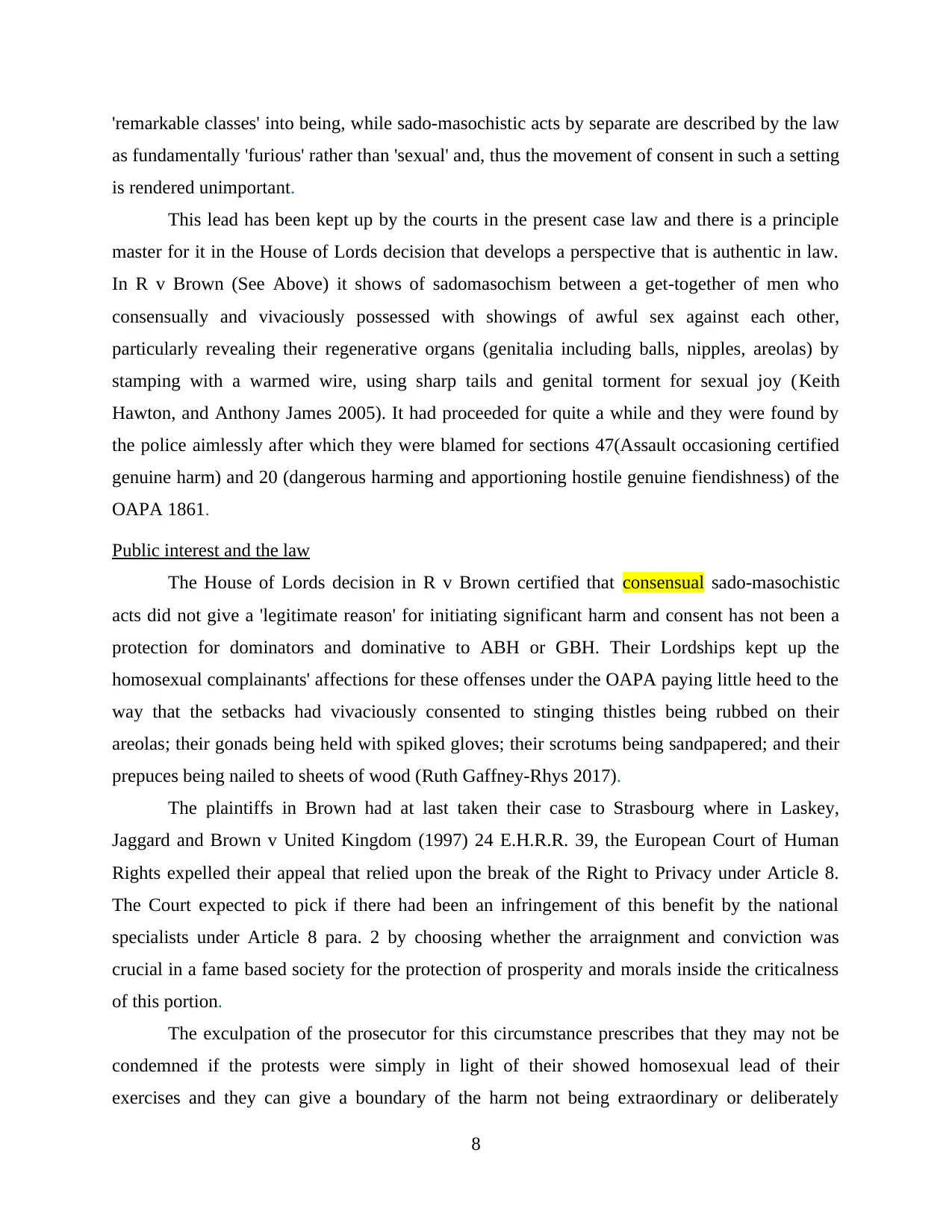
'remarkable classes' into being, while sado-masochistic acts by separate are described by the law
as fundamentally 'furious' rather than 'sexual' and, thus the movement of consent in such a setting
is rendered unimportant.
This lead has been kept up by the courts in the present case law and there is a principle
master for it in the House of Lords decision that develops a perspective that is authentic in law.
In R v Brown (See Above) it shows of sadomasochism between a get-together of men who
consensually and vivaciously possessed with showings of awful sex against each other,
particularly revealing their regenerative organs (genitalia including balls, nipples, areolas) by
stamping with a warmed wire, using sharp tails and genital torment for sexual joy (Keith
Hawton, and Anthony James 2005). It had proceeded for quite a while and they were found by
the police aimlessly after which they were blamed for sections 47(Assault occasioning certified
genuine harm) and 20 (dangerous harming and apportioning hostile genuine fiendishness) of the
OAPA 1861.
Public interest and the law
The House of Lords decision in R v Brown certified that consensual sado-masochistic
acts did not give a 'legitimate reason' for initiating significant harm and consent has not been a
protection for dominators and dominative to ABH or GBH. Their Lordships kept up the
homosexual complainants' affections for these offenses under the OAPA paying little heed to the
way that the setbacks had vivaciously consented to stinging thistles being rubbed on their
areolas; their gonads being held with spiked gloves; their scrotums being sandpapered; and their
prepuces being nailed to sheets of wood (Ruth Gaffney-Rhys 2017).
The plaintiffs in Brown had at last taken their case to Strasbourg where in Laskey,
Jaggard and Brown v United Kingdom (1997) 24 E.H.R.R. 39, the European Court of Human
Rights expelled their appeal that relied upon the break of the Right to Privacy under Article 8.
The Court expected to pick if there had been an infringement of this benefit by the national
specialists under Article 8 para. 2 by choosing whether the arraignment and conviction was
crucial in a fame based society for the protection of prosperity and morals inside the criticalness
of this portion.
The exculpation of the prosecutor for this circumstance prescribes that they may not be
condemned if the protests were simply in light of their showed homosexual lead of their
exercises and they can give a boundary of the harm not being extraordinary or deliberately
8
as fundamentally 'furious' rather than 'sexual' and, thus the movement of consent in such a setting
is rendered unimportant.
This lead has been kept up by the courts in the present case law and there is a principle
master for it in the House of Lords decision that develops a perspective that is authentic in law.
In R v Brown (See Above) it shows of sadomasochism between a get-together of men who
consensually and vivaciously possessed with showings of awful sex against each other,
particularly revealing their regenerative organs (genitalia including balls, nipples, areolas) by
stamping with a warmed wire, using sharp tails and genital torment for sexual joy (Keith
Hawton, and Anthony James 2005). It had proceeded for quite a while and they were found by
the police aimlessly after which they were blamed for sections 47(Assault occasioning certified
genuine harm) and 20 (dangerous harming and apportioning hostile genuine fiendishness) of the
OAPA 1861.
Public interest and the law
The House of Lords decision in R v Brown certified that consensual sado-masochistic
acts did not give a 'legitimate reason' for initiating significant harm and consent has not been a
protection for dominators and dominative to ABH or GBH. Their Lordships kept up the
homosexual complainants' affections for these offenses under the OAPA paying little heed to the
way that the setbacks had vivaciously consented to stinging thistles being rubbed on their
areolas; their gonads being held with spiked gloves; their scrotums being sandpapered; and their
prepuces being nailed to sheets of wood (Ruth Gaffney-Rhys 2017).
The plaintiffs in Brown had at last taken their case to Strasbourg where in Laskey,
Jaggard and Brown v United Kingdom (1997) 24 E.H.R.R. 39, the European Court of Human
Rights expelled their appeal that relied upon the break of the Right to Privacy under Article 8.
The Court expected to pick if there had been an infringement of this benefit by the national
specialists under Article 8 para. 2 by choosing whether the arraignment and conviction was
crucial in a fame based society for the protection of prosperity and morals inside the criticalness
of this portion.
The exculpation of the prosecutor for this circumstance prescribes that they may not be
condemned if the protests were simply in light of their showed homosexual lead of their
exercises and they can give a boundary of the harm not being extraordinary or deliberately
8
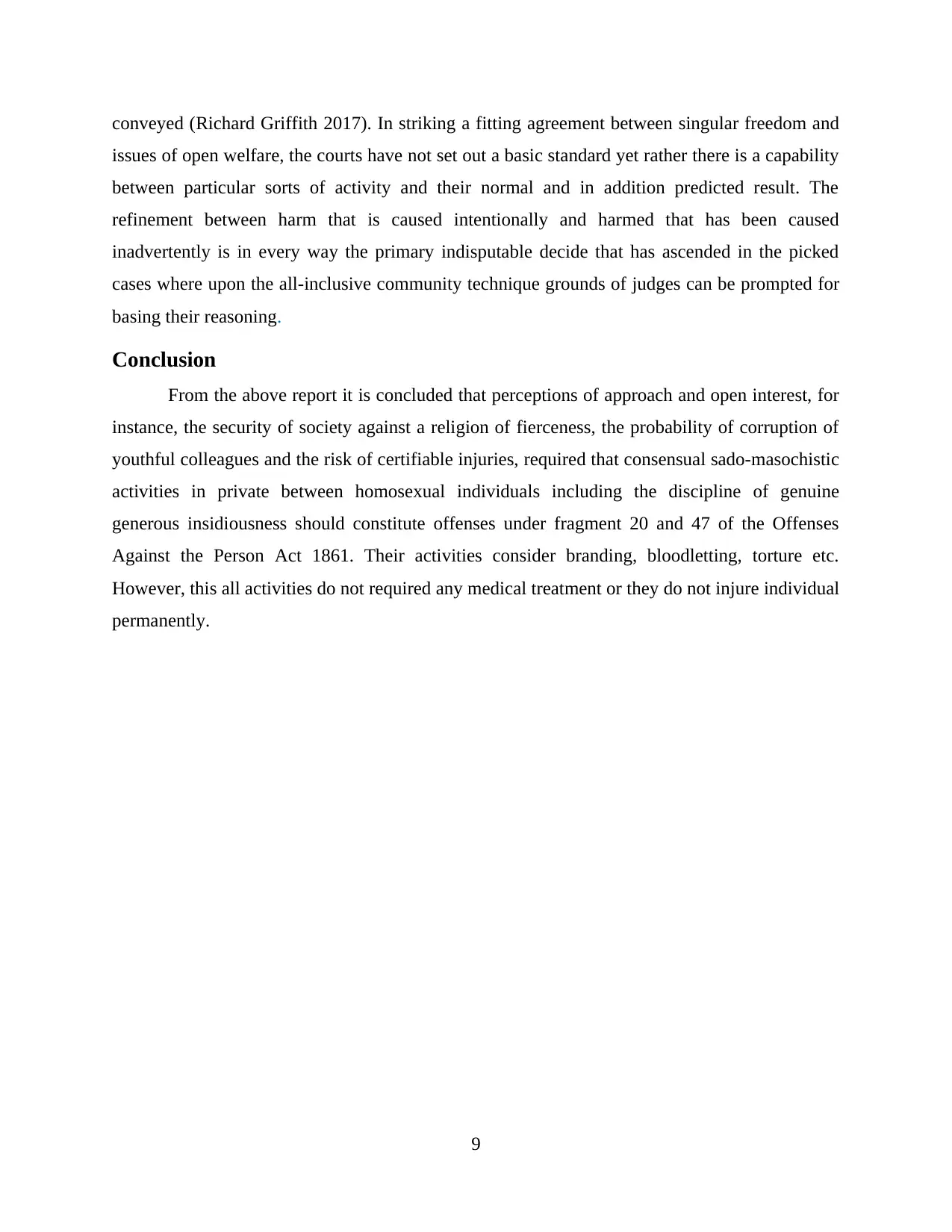
conveyed (Richard Griffith 2017). In striking a fitting agreement between singular freedom and
issues of open welfare, the courts have not set out a basic standard yet rather there is a capability
between particular sorts of activity and their normal and in addition predicted result. The
refinement between harm that is caused intentionally and harmed that has been caused
inadvertently is in every way the primary indisputable decide that has ascended in the picked
cases where upon the all-inclusive community technique grounds of judges can be prompted for
basing their reasoning.
Conclusion
From the above report it is concluded that perceptions of approach and open interest, for
instance, the security of society against a religion of fierceness, the probability of corruption of
youthful colleagues and the risk of certifiable injuries, required that consensual sado-masochistic
activities in private between homosexual individuals including the discipline of genuine
generous insidiousness should constitute offenses under fragment 20 and 47 of the Offenses
Against the Person Act 1861. Their activities consider branding, bloodletting, torture etc.
However, this all activities do not required any medical treatment or they do not injure individual
permanently.
9
issues of open welfare, the courts have not set out a basic standard yet rather there is a capability
between particular sorts of activity and their normal and in addition predicted result. The
refinement between harm that is caused intentionally and harmed that has been caused
inadvertently is in every way the primary indisputable decide that has ascended in the picked
cases where upon the all-inclusive community technique grounds of judges can be prompted for
basing their reasoning.
Conclusion
From the above report it is concluded that perceptions of approach and open interest, for
instance, the security of society against a religion of fierceness, the probability of corruption of
youthful colleagues and the risk of certifiable injuries, required that consensual sado-masochistic
activities in private between homosexual individuals including the discipline of genuine
generous insidiousness should constitute offenses under fragment 20 and 47 of the Offenses
Against the Person Act 1861. Their activities consider branding, bloodletting, torture etc.
However, this all activities do not required any medical treatment or they do not injure individual
permanently.
9
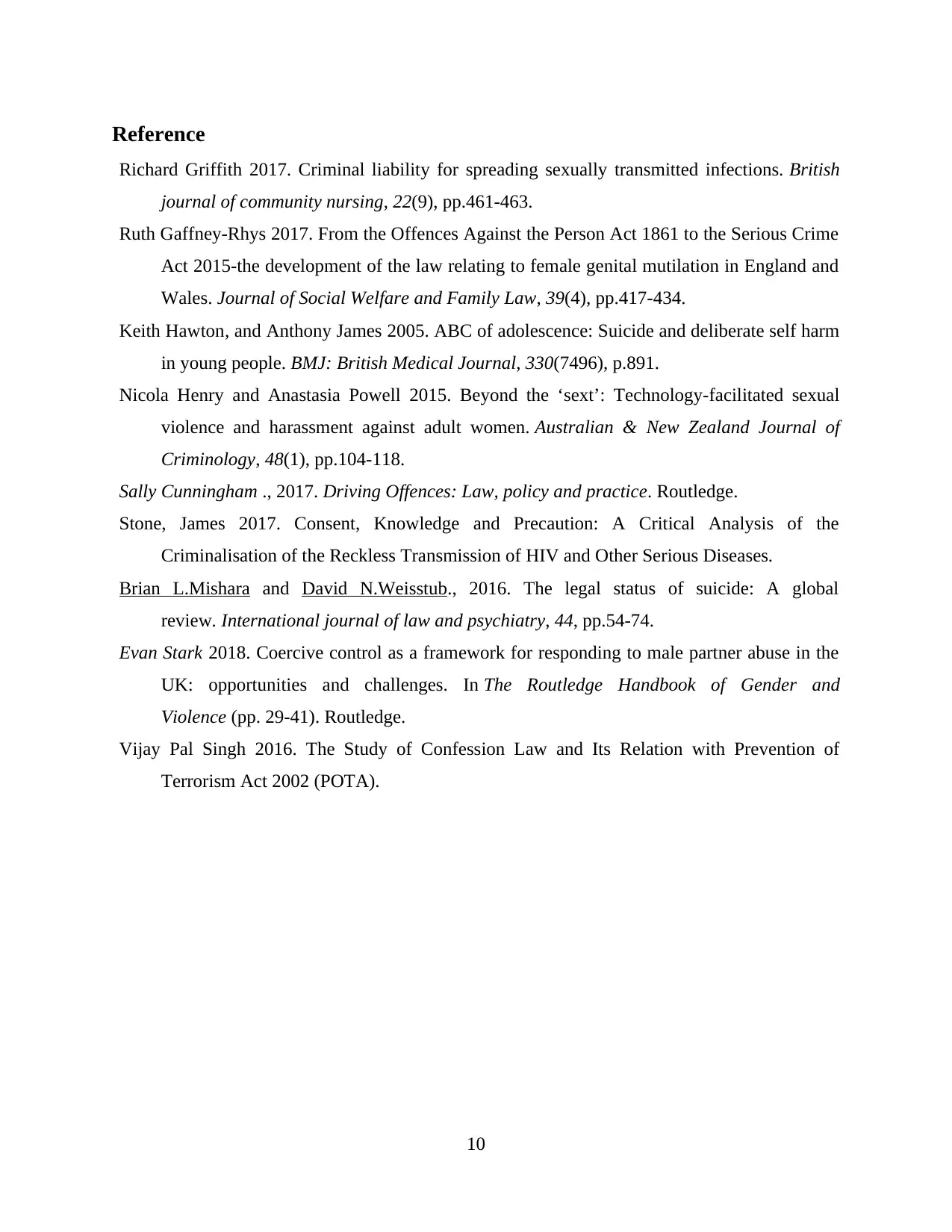
Reference
Richard Griffith 2017. Criminal liability for spreading sexually transmitted infections. British
journal of community nursing, 22(9), pp.461-463.
Ruth Gaffney-Rhys 2017. From the Offences Against the Person Act 1861 to the Serious Crime
Act 2015-the development of the law relating to female genital mutilation in England and
Wales. Journal of Social Welfare and Family Law, 39(4), pp.417-434.
Keith Hawton, and Anthony James 2005. ABC of adolescence: Suicide and deliberate self harm
in young people. BMJ: British Medical Journal, 330(7496), p.891.
Nicola Henry and Anastasia Powell 2015. Beyond the ‘sext’: Technology-facilitated sexual
violence and harassment against adult women. Australian & New Zealand Journal of
Criminology, 48(1), pp.104-118.
Sally Cunningham ., 2017. Driving Offences: Law, policy and practice. Routledge.
Stone, James 2017. Consent, Knowledge and Precaution: A Critical Analysis of the
Criminalisation of the Reckless Transmission of HIV and Other Serious Diseases.
Brian L.Mishara and David N.Weisstub., 2016. The legal status of suicide: A global
review. International journal of law and psychiatry, 44, pp.54-74.
Evan Stark 2018. Coercive control as a framework for responding to male partner abuse in the
UK: opportunities and challenges. In The Routledge Handbook of Gender and
Violence (pp. 29-41). Routledge.
Vijay Pal Singh 2016. The Study of Confession Law and Its Relation with Prevention of
Terrorism Act 2002 (POTA).
10
Richard Griffith 2017. Criminal liability for spreading sexually transmitted infections. British
journal of community nursing, 22(9), pp.461-463.
Ruth Gaffney-Rhys 2017. From the Offences Against the Person Act 1861 to the Serious Crime
Act 2015-the development of the law relating to female genital mutilation in England and
Wales. Journal of Social Welfare and Family Law, 39(4), pp.417-434.
Keith Hawton, and Anthony James 2005. ABC of adolescence: Suicide and deliberate self harm
in young people. BMJ: British Medical Journal, 330(7496), p.891.
Nicola Henry and Anastasia Powell 2015. Beyond the ‘sext’: Technology-facilitated sexual
violence and harassment against adult women. Australian & New Zealand Journal of
Criminology, 48(1), pp.104-118.
Sally Cunningham ., 2017. Driving Offences: Law, policy and practice. Routledge.
Stone, James 2017. Consent, Knowledge and Precaution: A Critical Analysis of the
Criminalisation of the Reckless Transmission of HIV and Other Serious Diseases.
Brian L.Mishara and David N.Weisstub., 2016. The legal status of suicide: A global
review. International journal of law and psychiatry, 44, pp.54-74.
Evan Stark 2018. Coercive control as a framework for responding to male partner abuse in the
UK: opportunities and challenges. In The Routledge Handbook of Gender and
Violence (pp. 29-41). Routledge.
Vijay Pal Singh 2016. The Study of Confession Law and Its Relation with Prevention of
Terrorism Act 2002 (POTA).
10
1 out of 10
Related Documents
Your All-in-One AI-Powered Toolkit for Academic Success.
+13062052269
info@desklib.com
Available 24*7 on WhatsApp / Email
![[object Object]](/_next/static/media/star-bottom.7253800d.svg)
Unlock your academic potential
© 2024 | Zucol Services PVT LTD | All rights reserved.




